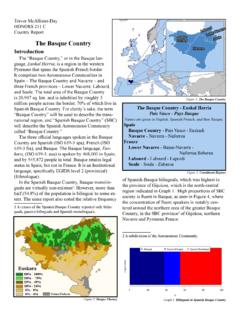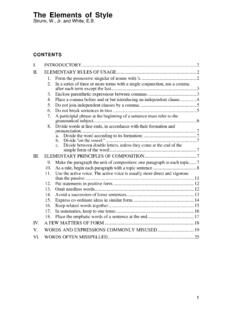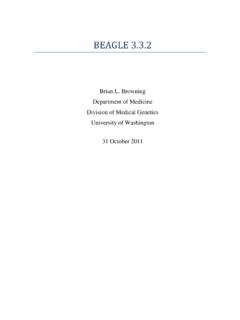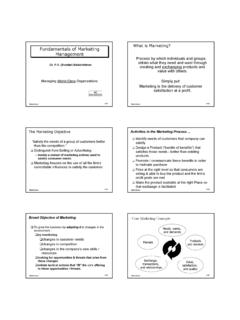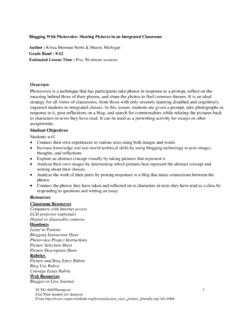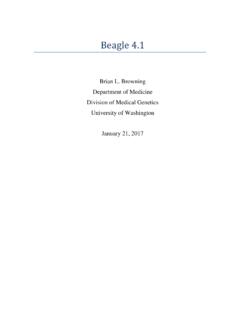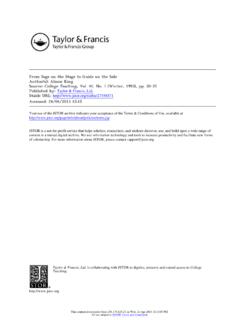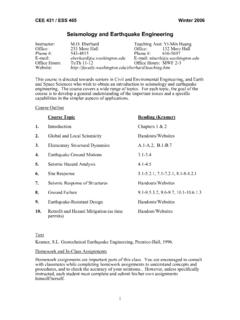Transcription of Surgical Technique - University of Washington
1 SHOULDER FRACTURE System Surgical Technique Univers SHOULDER FRACTURE SYSTEM. DESIGN RATIONALE. Conventional shoulder implants are frequently not suitable for optimal reconstruction of proximal humeral fractures because of the loss of anatomic orientation features and the inability to adequately reduce and securely fix the displaced tuberosity fragments. Through the unique design of the implant and instrumentation, the Arthrex Univers Shoulder Fracture System will address all of the issues relating to stabilization of the humeral prosthesis, accurate positioning of the humeral head combined with a straightforward reproducible protocol to accurately reduce and fix the tuberosities. The system includes: A preoperative and intraoperative measuring guide to accurately set the humeral head height without the need for technically demanding and complicated fracture jigs. Intraoperative adjustable humeral head prosthesis for secondary correction of the implant head height.
2 Lateral fin positions with suture eyelets for anatomic reconstruction of the tuberosities. Multiple suture eyelets on the Trunion Flange to prevent secondary displacement of the tuberosities. Smooth chamfered dimples in the medial aspect of the humeral stem to allow suture fixation of the tuberosities fragments without causing fraying and breakage. Variable eccentric adjustment of the humeral head for anatomic reconstruction. INDICATIONS. The Univers fracture prosthesis is indicated for treatment of severe pain or significant disability resulting from degenerative, rheumatoid, or traumatic disease or injury of the glenohumeral joint. These indications would include traumatic or pathologic conditions of the shoulder resulting in fractures of the glenohumeral joint, comminuted fractures, humeral head fractures, displaced three or four part proximal humerus fractures, avascular necrosis of the humeral head and fractures of the anatomic neck.
3 The shoulder humeral fracture prosthesis is designed for cemented or cementless use. This device may be used for hemi or total shoulder arthroplasty using the appropriate Univers Glenoid component, which must be cemented. 1 2. The Preoperative Measuring Guide is placed on the The shoulder is prepped to ensure free mobility of the contralateral shoulder and a true A/P image of the limb including the shoulder and elbow joint. Incision humerus, in the neutral position, is obtained to and dissection is carried out through a deltopectoral determine the appropriate height of the humerus. approach to protect surrounding soft tissues and neurovascular structures from injury. As dissection is carried out to the level of the fracture the subscapularis muscle and tendon attachment to the humerus is identified and a series of #2 FiberWire sutures are placed into the medial portion of the subscapularis muscle and tendon.
4 Once the subscapularis muscle has been taken down, with or without the presence of a bony component, the arm may be externally rotated further exposing the fracture pattern. Appropriate tag sutures are placed in the respective tuberosity components and the humeral head is removed and sized prior to humeral canal preparation. Attach the T-Handle to the 8 mm reamer. Advance the reamer down the humeral canal until the first circumferential groove is even with the shaft fracture line. Continue reaming with progressively larger reamer sizes until resistance is felt from the cortical bone. For noncemented application, select the implant which corresponds to the final reamer size. If cementing the stem is desired, an implant equal to or one size smaller than the final reamer size is recommended. Two holes are drilled in the humeral shaft on either side of the bicipital 3 groove 1 cm inferior to the fracture, accommodating later suture placement and tuberosity repair.
5 4 5. The appropriate size Stem Impactor is attached to the The Intraoperative Measuring Guide is assembled Fracture Stem by aligning the two rod-shaped devices and preset to the height taken from the Preoperative on the Impactor to fit snugly behind the lateral fins of Measuring Guide. When the elbow is positioned onto the stem. The Trial Head is now applied to the implant the Interoperative Measuring Guide, the metal pointer and the Version Rod is attached to the Stem Impactor. will indicate the correct height the implant should be. Note: The Trial Heads have offset positions for either the The Version Rod is aligned with the forearm to establish left or right shoulder. The position adjacent to the hash 20 of retroversion. A mallet is used to fully seat the mark results in an average posterior offset. More or less implant. The implant head height can now be adjusted. offset may be selected to reproduce symmetrical tension on the rotator cuff.
6 7. 6 Once the head height adjustments have been made, the locking screw is tightened to lock the jack-screw mechanism. A side specific locking screwdriver labeled left or right that corresponds with the operative From the initial (middle) position the prosthesis head shoulder is selected from the instrument tray. The can be adjusted in a superior and inferior direction, a design of the uni-directional locking screwdriver total of 15 mm ( mm superior and mm inferior). prevents rotation of the locking mechanism in a This will allow the surgeon to fine-tune the head height direction contrary to the intended locked position. from the initial insertion position. The head height is The appropriate locking screwdriver is inserted into adjusted by rotating the jack-screw located in the proximal the set screw and rotated until it is tight. portion of the implant using the large screwdriver.
7 Prior Note: Once the locking screw has been tightened, it may to locking the head height, a trial reduction is performed. not be possible to unlock for further adjustments. 8 9. Should the Humeral Stem need to be removed, The Extractor/Adapter is removed from the stem by the Extractor/Adapter is attached to the superior depressing the small spring-loaded pin on the side of lateral corner of the Stem. The nipple end of the the Extractor/Adapter. Slap Hammer slides into the receiving slot on the Extractor/Adapter. 10. 11. The Trial Head is removed to access the Trunion Flange holes. Two FiberWire sutures are threaded Three FiberWire sutures are positioned through the through the posterior Trunion Flange holes and tendon-bone junction and around the medial prosthesis sutured through the bone tendon junction of the major neck. Each suture is then fed through one of the holes tuberosity.
8 These sutures prevent the tuberosity from in the lateral fin. moving behind or over the prosthetic head. The Trial Head can be reattached to ensure that the appropriate soft tissue tension is achieved. 12 13. The lesser tuberosity is reduced with two FiberWire The lesser tuberosity is positioned around the prosthesis sutures through the Trunion Flange holes and through neck and fixed with three FiberWire sutures through the tendon/bone junction. Autogenous bone graft the bone/tendon junction. These sutures are threaded may be taken from the humeral head with a small through the lateral fin holes where the major tuberosity curette and packed between the humeral shaft, the is already fixed. Prior to tying all the sutures, the Trial tuberosity and the implant. Head is adjusted to the appropriate offset position. The prosthetic head is then opened, poitioned with selected offset and impacted onto the Humeral Stem.
9 Sutures are then tied securely. 14 15. FiberWire sutures are used to secure the shaft to the The rotator interval is sutured and a biceps tenodesis tuberosities using a tension band weave. These vertical is performed. tension band sutures are used to ensure the tuberosity fragments are mechanically attached to the humeral shaft to prevent proximal migration. Ordering Information Univers Fracture Instrument Set AR-9201S. Accessories: #2 FiberWire, 38 inches (blue) w/Tapered Needle, mm, 1/2 circle, qty. 12 AR-7200. #2 FiberWire, 38 inches w/Reverse Cutting Needle, mm, 1/2 circle, qty. 12 AR-7202. #5 FiberWire, 38 inches (blue) AR-7210. #5 FiberWire, 38 inches w/Conventional Cutting Needle, 48 mm, 1/2 circle, qty. 12 AR-7211. FiberWire Tensioner AR-1929. FiberWire Suture Kit AR-7219. Implants: Humeral Stem, fracture, 8 mm x 158 mm AR-9100-08F. Humeral Stem, fracture, 9 mm x 173 mm AR-9100-09F Humeral Stem, fracture, 10 mm x 180 mm AR-9100-10F.
10 Humeral Stem, fracture, 11 mm x 187 mm AR-9100-11F. Humeral Stem, fracture, 12 mm x 195 mm AR-9100-12F Humeral Stem, fracture, 13 mm x 204 mm AR-9100-13F. Humeral Head, fracture, 43 mm x 15 mm AR-9143-15F. Humeral Head, fracture, 46 mm x 17 mm AR-9146-17F. Humeral Head, fracture, 48 mm x 17 mm AR-9148-17F. Humeral Head, fracture, 50 mm x 19 mm AR-9150-19F. Humeral Head, fracture, 51 mm x 22 mm AR-9151-22F. Arthrex, Inc. 1370 Creekside Boulevard, Naples, Florida 34108-1945 USA. Tel: 239-643-5553 Fax: 239-598-5534 Web site: Arthrex GmbH. Liebigstrasse 13, 85757 Karlsfeld/Munich Germany Tel: +49-8131-59570 Fax: +49-8131-5957-565. Arthrex Iberoam rica Howard Hughes Tower, 6701 Center Drive West, Suite 550, Los Angeles, California 90045 USA. Tel: 310-670-6080 Fax: 310-670-6087. Arthrex 5 Avenue Pierre et Marie Curie, 59260 Lezennes France Tel: +33-3-20-05-72-72 Fax: +33-3-20-05-72-70.
